|
|
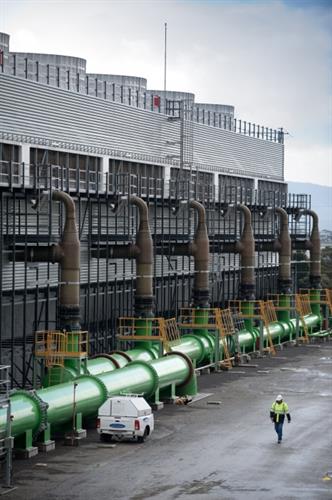 By Jo Nova By Jo Nova
The real cost of back up
Imagine building and maintaining a perfectly good gas plant and then having it sit around for five whole years “just in case”?
There’s been a wind drought in the last three months in Australia, which meant hydro power had been used more than expected to fill the gap. But wouldn’t you know it, it’s been dry spell for most of the last year in Tasmania too and the dams were getting low. So on June 6th, the Combined Cycle Gas plant at Tamar Valley was set up to run for the first time since 2019.
Back in 2016 the maintenance costs of the keeping the CCGT at Tamar Valley on “30 day” standby was $12 to $24 million a year, depending on who you asked. So the five year cost of gas backup is in the order of $100 million, but those costs will be slapped on the gas plant bill, when really they’re a weather dependent renewables cost. What we need is reliable energy, not random electricity. If energy companies were only paid for reliable dispatchable power, the wind and solar plants would have to build their own “back up gas plants” that sit around idle for years, and juggle their own generators. So they’d all go out of business by breakfast. Why build a perfectly good gas plant with vast wind and hydro complex, when you could just build the gas plant and get what you need? Fossil fuels are essential, renewables are superfluous weather-changing talismen.
From WattClarity: This confirms that it’s the first time in just over 5 years that the combined cycle unit has seen a run!
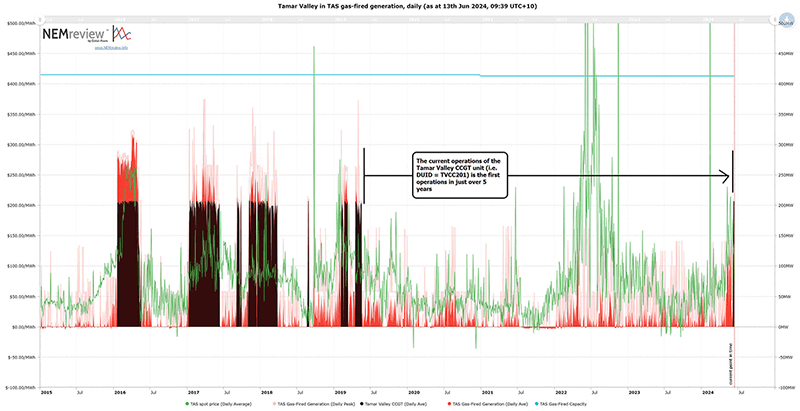 … Naturally Hydro Tasmania blame the drought, not the failing wind farms. But when the wind doesn’t blow, hydro likes to make profits from the price spikes, and there have been plenty of those lately.
In 2009 the whole gas plant was built for $230 million dollars. But the 2016 power debacle where the Basslink cable broke during a drought, cost the state $560 million dollars.
The only thing worse than the cost of back up power, is the cost of blackouts.

The Tamar Valley Power Station has four units, three are peaking gas units (adding up to 178MW), and one more efficient baseload turbine (CCGT) of 210MW.
[UPDATE: CCGT corrected to “Combined Cycle”. Apologies. – Jo]
Photo from: Tas Hydro
10 out of 10 based on 103 ratings
9.1 out of 10 based on 14 ratings

By Jo Nova
Le Pen has weaponized ‘punitive’ environmental policies, and voters seem to like that
In the largest turnout since 1981, French voters chose the “Far Right” National Rally party in a record vote of 33 per cent. It is the first round of voting with the second on July 7th, but The Washington Post is already comparing the potentially “shocking” French election result with the 2016 Brexit win in the UK. The Guardian said the unthinkable has become plausible.
, Le Monde
After long neglecting environmental issues, the far-right party has made the denunciation of allegedly ‘punitive’ environmental policies into its new electoral weapon.
The former presidential candidate railed against “Brussels,” which “forces you, almost overnight, to change your boiler for €15,000,” against the “authoritarian reductions to agricultural land” and against the “heartless European Commission.”
“Don’t they have as their objective the reduction of human activity as a whole?” she asked, before connecting the issue to her obsession with French people’s daily lives, a strategy that has brought the RN to the threshold of coming to power. “It’s always the same logic of degrowth, which leads them to ban the sale of internal combustion engines in 2035, and thus deliberately program the sacking of our automotive industry and dependence on China,” she continued.
Long downplayed or mocked, environmental issues are now a core part of the RN’s political strategy.
Pierre Haski, in the Guardian: “This is a real tragedy”
… I always had the naive idea that “reasonable” people, from the right as well as from the left, would never let them win. …I woke up this morning to a different country, one in which the Le Pen clan is at the gates of power.
We can also wonder why this country, with its many assets, has generated enough anger and resentment among its citizens to produce an election result that is more likely to damage its economy and social cohesion than solve real problems. We can also question a French political elite that was so blind it let the far right prosper in large corners of a society that felt forgotten and despised.
Reasonable people live in the cities of course, and delusional people farm the land.
All of this is true, and is being discussed everywhere now in France, among friends, colleagues and in our family circles. Everyone is looking in the mirror and wondering what to do next Sunday in the second round. At the very least, we’ll have to learn to live in a divided land where the National Rally controls small towns and vast areas of rural France, while the “reasonable” people have the upper hand in major cities including Paris. This is a real tragedy.
Imagine learning to live in a “land divided”?
Indeed, according to CarbonBrief this is Marine Le Pens tragic manifesto — something about protecting the standard of living:

Their original policies (in French): Rassemblement National.
PS: Forgive me, I forgot to mention the obvious, but it needs to be said: “Far Right” and “Extreme Right”, as applied to a third of the population, are just the fake labels of the word-smithing liars on the left. Sleepy voters in-the-middle may be fooled by this cheap name-calling tactic, scared of voting for something “extreme”. But liars are vulnerable — every time we point out the lie, they pay the price.
Photo Macron: Defense Visual Information Distribution Service
9.7 out of 10 based on 111 ratings
8.6 out of 10 based on 14 ratings
9 out of 10 based on 27 ratings
8.3 out of 10 based on 21 ratings
 By Jo Nova By Jo Nova
The Democrats needed a reason to dump their placeholder candidate for 2024, and that convention is coming soon. Obviously they want to drop in a new candidate at the last minute with just enough time to ride home on the honeymoon glow. Debates are not usually held before the conventions.
They were always going to throw Biden under the bus, but this way they stop him being the lame duck for as long as possible while they protect their real candidate from scrutiny. Republicans counting chickens at this point are far too relaxed.
Flag: Clément Bardot
9.9 out of 10 based on 125 ratings
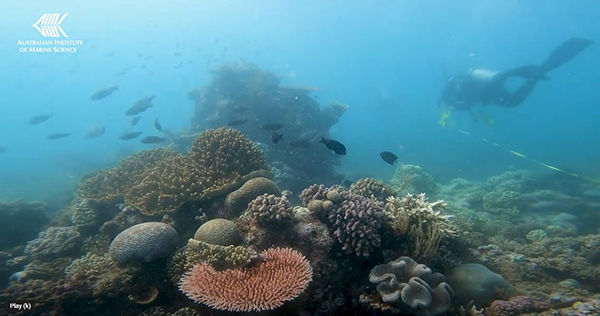
By Jo Nova
Sixty percent of all human CO2 emissions have been emitted since 1985 but today the corals are healthier than ever
In 1985 humans were emitting only 19.6 billion tons of CO2 each year, and now we emit 37 billion tons. In the meantime AIMS have been dragging divers thousands of kilometers over the reefs to inspect the coral cover. These are the most detailed underwater surveys on the largest reef system in the world, and they show that far from being bleached to hell, the corals are more abundant than we have ever seen them.
As Peter Ridd points out, when the reef was doing badly, AIMS was happy to combine the data on the whole reef, so we could lament its demise. But lately AIMS splits it into separate sections and if Peter Ridd didn’t check the numbers, who would know it was a record across the full 2,300 kilometer length of the reef? And that may be exactly the point. As Ridd reminds us, in 2012 the AIMS team predicted the coral cover in the central and southern regions would decline to 5 – 10 percent cover by 2022. Instead the whole reef is thriving at 30 percent.
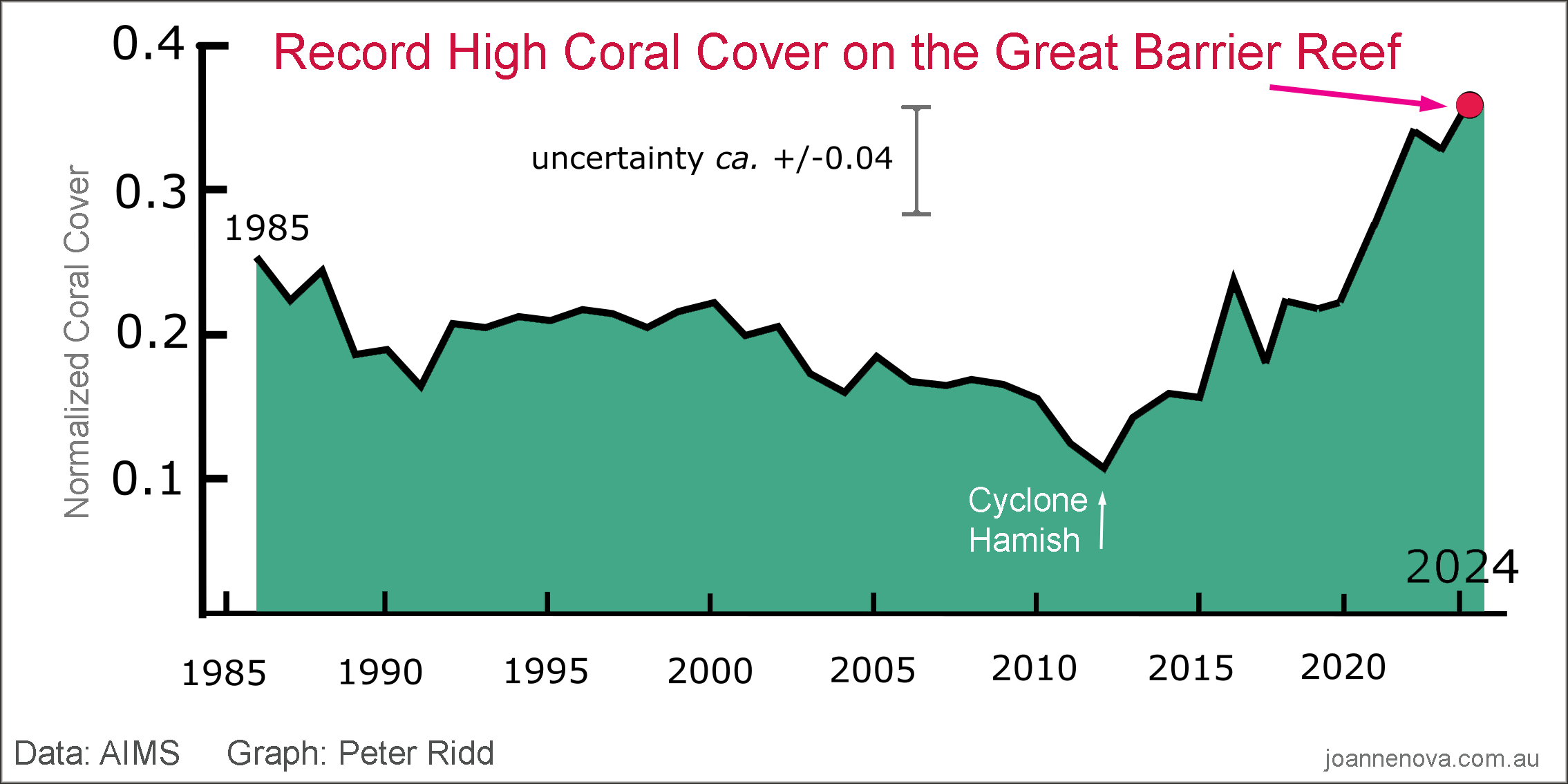 … Meanwhile preposterous power games continue
UNESCO has been threatening to slap an endangered label on the reef for years. They would have looked ridiculous if they had done this whilst corals were at a record high. But that didn’t stop them demanding tribute and conditions anyway, as if Australia can’t manage the reef by itself. Our Prime Minister should have laughed at them and cut UN funding until they start making sense.
By Graham Lloyd, The Australian
The UNESCO recommendation that the World Heritage Committee not proscribe the reef as “in danger” at its meeting next month no doubt has come as a big relief for government but it still has plenty of strings attached. To keep favour with UNESCO, governments must ban all gillnet fishing by mid-2027 and more closely supervise land activities stretching hundreds of kilometres inland from the coastline, and further still from the reef itself. It must also keep the billions of dollars flowing for research and reef management.
Who runs the country, is it our elected government or a foreign committee at the service of third world dictators?
The Greens, unfortunately, still struggle with big-numbers, or any numbers at all:
The Greens say the UNESCO decision is a “triumph of lobbying and spin over science”. “The burning of fossil fuels is literally cooking our oceans and degrading marine ecosystems across the globe, and nowhere else has this been more politicised than on the Great Barrier Reef,” says Greens spokesman Senator Peter Whish-Wilson.
And who is politicizing The Great Barrier Reef more than The hyperbolic Greens themselves? No wonder Greens voters were the most confused in the AEF survey.
Ten years after our corals hit a record low, our survey showed that half the country didn’t realize the reef has recovered. Only 3% knew the corals were at a record high, and nearly half the Green voters were as wrong as they possibly could be — they thought coral cover was at a record low.
The full AIMS report will be released in August. There have been some bleaching events both before and after the survey, and as is normal, we won’t know for months whether any corals actually died or whether it was just the normal home renovation that corals go through when they get stressed. It’s common for corals to throw out the zooanthellae as temperatures change and let in newer house-guests that are better acclimatized. Since sea levels near Queensland were 1 -2 meters higher 6,000 years ago, and the world was a lot warmer, corals can clearly look after themselves.
As Peter Ridd says the biggest threats to the reef are cyclones and crown-of-thorns starfish plagues, neither of which appear to be any worse now than they were years ago.
REFERENCES
Cumulative CO₂ emissions by world region: OWID (CO2 cumulative emissions were 687 bt in 1985 and 1,700 billion by 2022)
AIMS data
9.6 out of 10 based on 97 ratings
8.7 out of 10 based on 10 ratings

By Jo Nova
A little tiny delated backdown from extreme climate hype begins
In 2018, a study of aerial photos of 700 Pacific Islands showed that 89% were the same size or growing. This rather destroyed the idea that sea levels were swallowing small nations. The New York Times said nothing. Indeed, the only Pacific things shrinking were deserted sand drifts. No islands bigger than 10 hectares were getting smaller. Measured in square kilometers that’s “0.1”. Despite the media headlines and delegations from Kiribati and Tuvulu begging for money to hold back the tide, no islands with people living on them were shrinking. None, not one island in the Pacific big enough to matter, was disappearing. The largest 630 islands in the Pacific had not being touched by climate change for decades.
In 2023 another study of 1,100 islands came to the same conclusion. To find that many islands they included things as small as one thousandth of a square kilometer — we’re talking about spits of sand 10 meters square. (There are whales larger than that.) The Kench team studied islands in the Indian Ocean too. In one case, they sliced, diced and drilled through one poor island in the Maldives and discovered it had a history like tossed salad. The ocean had churned and turned every part of it.
Now, six years later, the New York Times is catching up on one small part — the Maldives, they admit, are not vanishing like they were supposed to. But the Times are still not saying that the original study came out in 2018, and that hundreds of media stories on sea levels were wrong, out of date and pointless, and all the claims of damage by Pacific Islanders were not just grossly exaggerated but utterly baseless. They’re not saying that all the anxiety that ideological scientists and sloppy journalists have whipped up has probably harmed the very islanders they pretended to care about. They’re not admitting that this must have been obvious to many of the islanders who lived there, surely, but who were happy to milk the fake crisis for all it was worth.

By Raymond Zhong
Then, not very long ago, researchers began sifting through aerial images and found something startling. They looked at a couple dozen islands first, then several hundred, and by now close to 1,000. They found that over the past few decades, the islands’ edges had wobbled this way and that, eroding here, building there. By and large, though, their area hadn’t shrunk. In some cases, it was the opposite: They grew. The seas rose, and the islands expanded with them.
Scientists have come to understand some but not all of the reasons for this….
And it’s always bad news, even when islands are stable:
Only later did scientists discover a key piece of their more recent history: Swings in sea level, they realized, had drowned and exposed the islands several times through the ages. Which didn’t bode particularly well for them today, now that global warming was causing the oceans’ rise to speed up.
The Times is pretending that the “surprise” here just means that the ocean giveth as much as it taketh away. It’s a bit of subsidence and a bit of churn. The seas, they say, nonsensically are still rising. (Of course). In the world of socialist propaganda, past wild swings in sea level don’t mean that the climate has always changed, and modern swings might be natural too. It just means ominously bad stuff, which… segue into a mention of man-made climate change.
They’re still not asking the sea level experts any hard questions, like, why didn’t you tell us this before, since we’ve had satellites since 1979? Didn’t you notice?
They’re not wondering if the UN knew this years ago and did nothing to inform the world.
The Times doesn’t question the sacred cow of rising sea levels — are the estimates of annual sea level rise really accurate? I mean, if no islands are disappearing, could those satellite estimates be wrong? Why do 1,000 tide gauges show seas are rising only 1mm a year, whereas the satellites say it’s 3mm a year? Is that because the satellite data was calibrated to a falling tide gauge in Hong Kong? Is it true that the raw satellite data showed very little rise in the 1990s, and that a lot of the rise is due to man-made adjustments?
And of course the biggy, the baddest question of all, if the islands are not sinking, the seas are not rising much, so is climate change all bollocks?
REFERENCE
Duvat, V. K. E. (2018). A global assessment of atoll island planform changes over the past decades. Wiley Interdisciplinary Reviews: Climate Change, e557. doi:10.1002/wcc.557
Kench, P.S., Liang, C., Ford, M.R. et al. (2023) Reef islands have continually adjusted to environmental change over the past two millennia. Nat Commun 14, 508 doi.org/10.1038/s41467-023-36171-2
10 out of 10 based on 101 ratings
10 out of 10 based on 16 ratings
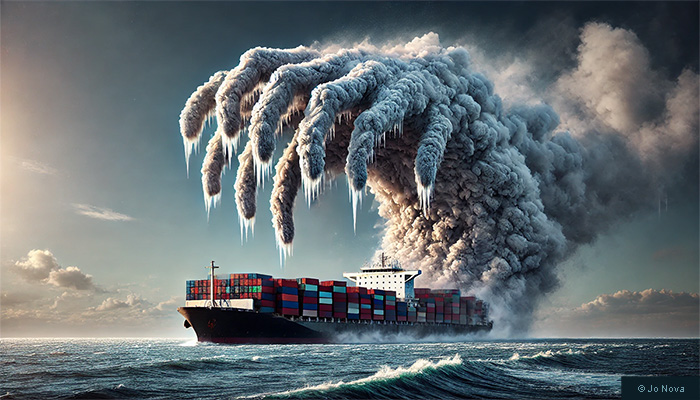
By Jo Nova
The evil shipping smoke was shielding us from global warming…
You’ll never guess but it’s worse than we thought, and we are more to blame than we thought, kiss my government grant and pray to Gaia.
Wouldn’t you know — shipping smoke was polluting the world, but the smoke also seeded clouds, which cooled the Earth, and undid some of the global warming we caused with CO2. Now that we are finally fixing up the dirty ships, oh no, we’ve accidentally unleashed the global warming which the ship smoke was hiding. So there is about to be another wave of global bad news. And for some reason we didn’t see it coming, even though we’ve known for decades that sulfate aerosols caused cooling (and we had those expert climate models all along, didn’t we?)
Remember all those other times they said disaster would strike, and it didn’t, well, they were right. It would have happened, we just couldn’t see it because of the shipping pollution.
See how perfect this is for The Climate Industrial Complex?
By Shannon Osaka, Washington Post
Tiny particles from the combustion of coal, oil and gas can reflect sunlight and spur the formation of clouds, shading the planet from the sun’s rays. Since the 1980s, those particles have offset between 40 and 80 percent of the warming caused by greenhouse gases.
“We’re starting from an area of deep, deep uncertainty,” said Zeke Hausfather, a climate scientist and research lead for the payments company Stripe. “It could be a full degree of cooling being masked.”
These moves have saved lives — according to estimates, around 200,000 premature deaths have already been avoided in China, and the new shipping regulations could save around 50,000 lives per year. But they have also boosted global temperatures. Scientists estimate that the changes in aerosols from the new shipping rule alone could contribute between 0.05 and 0.2 degrees Celsius of warming over the next few decades.
Some researchers have suggested that the changes to ocean shipping regulations may have been a big contributor to last year’s record heat…
All of which begs the question, if shipping-smoke solves global warming, shouldn’t we just go with it then?
I mean, let the ships rip, and skip the whole hair-shirt sacrifice — we could fly in planes, eat meat, and keep the air con on? But ‘no’ say the puritans, the new shipping regulations might save 50,000 people a year. (And heck, it’s not like we face the sixth mass extinction, boiling oceans, or something truly awful is it? ) So onward we go, renewables to the rescue, living the life of the perfect climate apostles.
The fact that the Ecoworriers won’t even consider this to save the world tells us exactly how afraid they are (not) of the man-made climate catastrophe.
And the other problem is “the numbers” — despite climate experts being 99% certain of what controls our climate, scientists estimate the changes in aerosols could have anything from 0.05°C to “a full degree” (so sayth Zeke Hausfather). So aerosols might explain a lot, or nothing at all, but it’s another excuse to parade a climate scientist on the news, and they can pick whatever flavour of “aerosol” cooling fits the theme of the day. Would you like to hide past model failures or scare the horses? Adjust to fit.
Watch the evil shipping smoke fighting off the Global Warming Monster
We are reminded yet again of the primitive belief that humans are really Gods that control the climate…

Some version of the shipping story keeps doing the rounds every few months for at least the last year, because it has a strong Climate Bingo score:
- It’s worse than we thought. The new bad effect is almost upon us (yet again!)
- It’s the perfect excuse to cover the warming that didn’t happen, wasn’t predicted, may not come, or might suddenly appear.
- It’s advertising for “Geoengineering Projects” where people throw salt, dust, or particulates in the sky and try to cool the Earth. (See, they say, Geoengineering works, give us your money!)
- It fits the religion — mankind controls the climate (not God or the Sun). This feeds a whole new wing of bureaucracy, and briefly distracts people from asking whether recent warming has anything to do with solar activity or space weather.
- Ultimately it bestows more power on the high priesthood of lab-coats and climate models — as long as the weather is controlled by man-made things of some sort, the IPCC anointed masters sit at the centre of this Global Warming Control Tower and issue the orders and collect the funds. They shall have their two-week UN junkets, their Nobel Pizzas, and their moment of fame in the nightly news.
But lift the hood, and this engine is a mass of contradictions. They didn’t see this “shipping” warming coming, and can’t agree on how much warming it does, but they want us to believe their models are accurate. And they don’t think the climate emergency is important enough to let ships keep shipping as they were, just to buy us some time. There are no hard trade-offs in these life and death decisions, only 50 shades of advertising for the renewables industry and the UN.
9.7 out of 10 based on 90 ratings
9 out of 10 based on 17 ratings
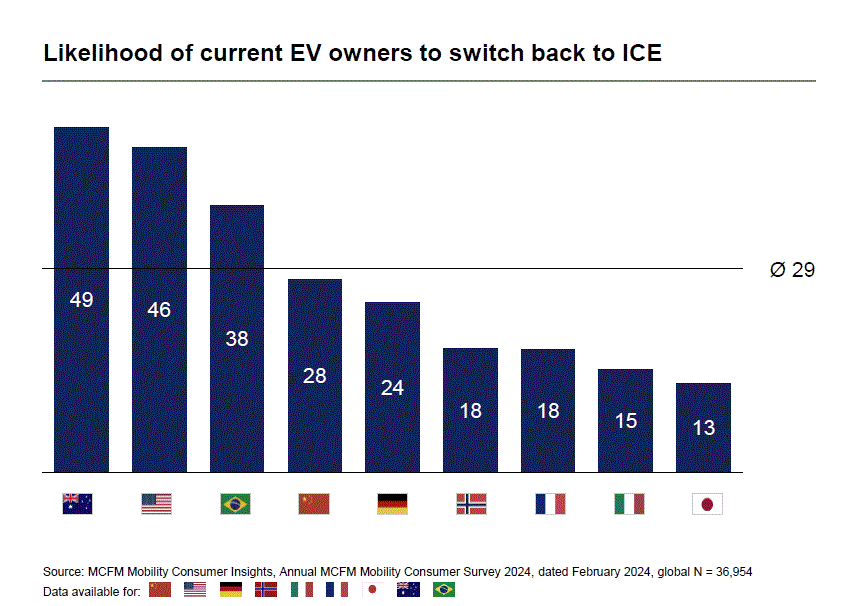 MKinsey Survey By Jo Nova
EV Mandated Revolution hits a hurdle

The first buyers of EV’s were their most passionate fans, and presumably the people-most-likely to love them, and in the best position to use them. Yet, when surveyed, 49% of Australians who owned an EV and 46% in the US said they want to go back to an internal combustion engine for their next car.
And the US and Australia are two nations where nearly everyone has a home-garage or driveway which makes EV ownership a bit easier (as long as the house doesn’t catch fire). Yet even with this cheaper and easier form of charging half the EV owners don’t want another one.
McKinsey & Co surveyed 30,000 people in 15 countries and were said to be surprised at the result.
Brad Matthews, The Washington Times
Nearly half of American owners of electric cars want to switch back to traditional cars powered by internal combustion engines, according to a consumer survey released by McKinsey and Co. earlier this month.
They had their reasons (boy did they have their reasons):
Among the owners surveyed who are planning to switch back, 35% cited the lack of charging infrastructure, 34% said the costs were too high, 32% said planning long driving trips was too difficult, 24% said they could not currently charge at home, 21% said worrying about charging was too stressful and 13% said they did not enjoy how the cars felt while driving.
Only 9% of drivers across all countries surveyed said that current charging infrastructure was sufficient to meet their needs. While some electric car drivers want to switch back, 38% of internal combustion car drivers surveyed said they are considering buying a battery-powered or plug-in hybrid electric car as their next vehicle.
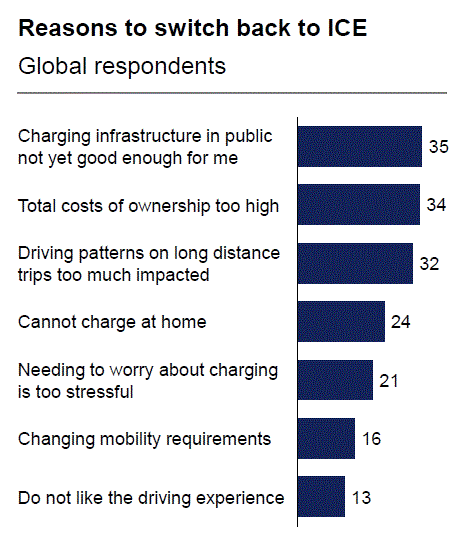
“I didn’t expect that. I thought, ’Once an EV buyer, always an EV buyer,’” Philipp Kampshoff, the leader of the McKinsey Center for Future Mobility, told Automotive News.
Since the McKinsey Centre for Future Mobility has a mission to help people “transform” the way they move, we would assume this survey was designed to show the more promising side of EV ownership.
The average EV owner planning to trade in for another EV around the world was 29%, so presumably there are some countries where EV’s are slightly less awful. Though that is not apparently in the British Isles. Actual trade-in statistics in the UK suggest the reality might be worse.
By Joe Wright, The Telegraph
“Car dealership chain Motorpoint Group said the majority of electric vehicle (EV) owners who sold their car in the last year didn’t buy another one – opting instead for a petrol, diesel or hybrid model.”
Statistics from Motorpoint show that only 30pc of EV owners part-exchanging their car in the past year chose to buy another electric car, with 36pc opting for petrol, 11pc diesel and 23pc hybrid.
Martin Bamford, a Tesla owner for four years, is one of the many electric car owners to switch back to combustion power in recent months. Despite driving a mostly trouble-free 34,000 miles, he suffered “instances of extreme range anxiety” and is ditching the zero-emission motor in favour of a 12-year-old Mini Cooper.
How much longer can the saviours of the world keep trying to force this dead-horse “transition” upon us?
The car manufacturers surely realize they are being forced into a financial dead end.
9.8 out of 10 based on 112 ratings
8.4 out of 10 based on 16 ratings
9.4 out of 10 based on 22 ratings

By Jo Nova
It wasn’t supposed to be this cold and windless in Australia
For some reason that no climate model can explain, Australia has run out of wind power three months in a row, which means we had to use more gas than expected. It’s also been colder than climate models predicted, despite global emissions being higher than ever in history. For some other reason that no rational adult can explain, the State of Victoria banned gas drilling for most of the last decade (to reduce the beachy-weather days in eighty years) and thus, as night follows day, the state is running out of gas. Ergo, predictably, it is also facing blackouts, cost blowouts and manufacturers dependent on gas are warning they may have to close down, or move to the US, where gas is still cheap.
If only the climate models could predict temperatures and wind even a month in advance?
The AEMO (our electricity grid manager) says Victoria will run out of gas before winter runs out of bite. Apparently Victorians are pulling twice as much gas out of their main storage as they can afford to at the moment. Not only does Victoria need the gas for electricity, but 80% of Victorian homes have gas for cooking or heating. And then there is manufacturing, not just in Victoria but most of Australia as gas prices rise all over the East Coast.
Who needs explosives and fertilizer, anyway?
Orica — one of the largest gas users in the country warned it may have to cut production and jobs in Newcastle due to the gas shortage. Since they supply explosives to the mining industry, and Australia is a big quarry, the repercussions would spread quickly.
By Perry Williams, and Rhiannon Down, The Australian
The nation is facing a deepening energy crisis on two fronts, with gas shortages so acute that Victoria’s main storage plant is set to run out by the end of winter and one of Australia’s biggest manufacturers warning it will slash jobs and close factories if supplies remain short.
German Morales, Orica’s president for Australia Pacific and sustainability, told The Australian that “there is not enough gas and there is not affordable gas”.
“Clearly if we fail to secure long-term gas at a reasonable market price, we may be put in a position of rethinking what is the manufacturing strategy for ammonia in Australia,” he said. “The Australian gas price is significantly more expensive than that you can buy in other jurisdictions, such as the US. That’s making it very difficult to justify manufacturing in Australia.”
And we thought wind generation was bad in April and May but June may be worse.
The awfulness of the fickle wind is upon us and reaching into our wallets. This was the total contribution of 11.5GW of wind generation to our national grid this month. Paul McArdle from WattClarity said the capacity factor for wind is as low as 21%.
Not-so-coincidentally on June 4th and June 13th when wind generation was exceptionally low, average prices in the whole system doubled (See below).
And this is a major problem with an electricity market that isn’t designed to find the cheapest solution for consumers. Cheerleaders like the CSIRO will still be saying “wind is cheap” when it’s obvious the lack of wind in a wind-dependent-system is very expensive. But these price spikes that were caused by wind turbines will be slapped on coal, gas or hydro, whatever rescued the grid, not on the wind industry. The more wind fails, the “higher” the prices are for its competitors. Neat eh? If only the “experts” at the CSIRO understood how unreliable wind drives up the cost of everything else on the grid.
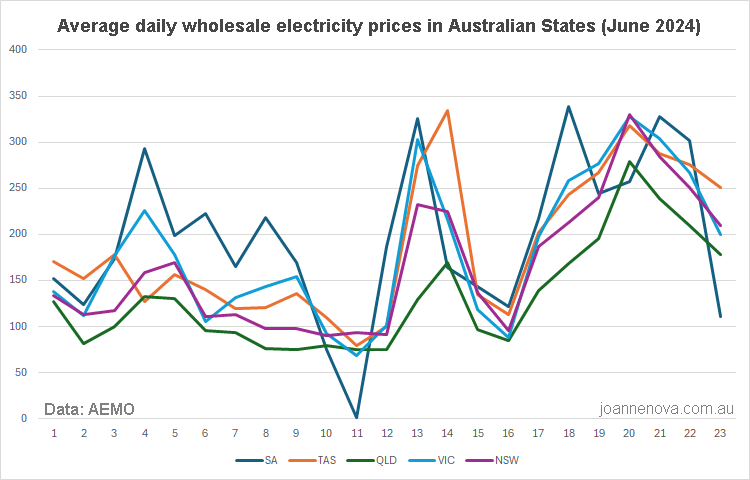 Bad days for wind were June 4th and June 13th, then most other days too. Those prices are awful and often obscenely high across all five states… On June 13th wind generation fell to just 88MW at lunchtime, and was low all day. The spike this produced is obvious.
Some of the lows like June 20th caused mayhem because they were hitting at dinner time when solar power has gone to bed. Back before the subsidized renewables gold rush, prices would average $30/MWh across the whole grid — not just all day, but all month. This month so far, average prices respectively are SA $197, Tas, $287, Qld $132, Vic $182, NSW $165.
It takes some skill to run out of gas when we are also one of the Big Three LNG exporters in the world, but the Australian government has achieved this. Incompetence knows no bounds:
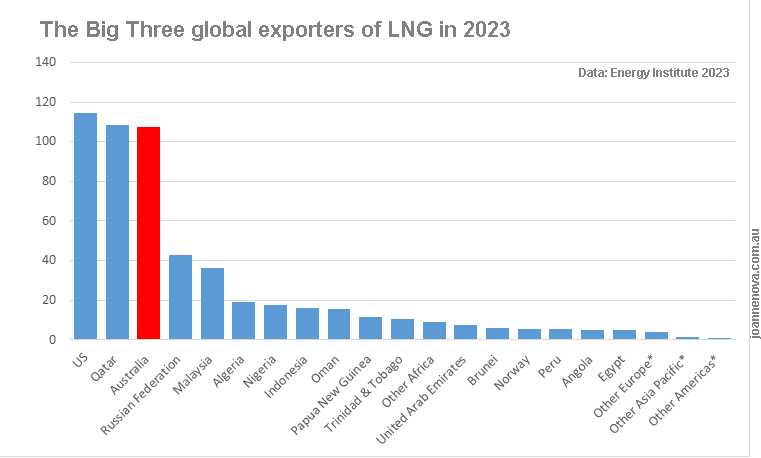
But hey, winter might be warm from now, who knows?
Not to belabor the point, but if we had decent climate models, we would know.
Gas price cap train wreck on the way
by Saul Kavonic, The Australian
The gas industry is scrambling to try to squeeze out any incremental supply, going as far as blending extra LPGs into the gas stream to eke out an extra per cent or two of production. Every lever to lift supply has now been pulled.
Australia’s energy market is one hiccup away from a major crisis, again. The gas market train wreck – long visible on the horizon – is now in front of us. Set in motion by Labor’s hostile gas policies since 2022, there are no easy levers left to pull to keep the lights on, while also keeping us warm in winter, and manufacturing jobs going. And it is only going to get worse in the years ahead.
If we run out of gas, we’ll just have to burn diesel, or sit in the dark, banging our heads on a cold wall.
Image by ThankYouFantasyPictures from Pixabay
10 out of 10 based on 124 ratings
9.1 out of 10 based on 36 ratings
9.1 out of 10 based on 21 ratings
By Jo Nova
We may be living through some of the best weather in the last 100,000 years
Kenneth Richard at NoTricksZone reports on a new paper showing the incredible extreme climate shifts of Greenland. During the depths of the last ice age Greenland temperatures would swing abruptly by 10 to 15 degrees Celsius (or 30F) in the space of 30 years. And we’re panicking at the moment about warming at 0.13°C per decade.
These Dansgaard–Oeschger (D–O) events occurred 24 times from 120,000 years ago until 11,000 years ago. There were no humans living there at the time, as far as we know. The best estimate is that people first arrived in Greenland 4,500 years ago. As far as we know, it’s only Greenland that was gyrating wildly in temperature but the bare truth about climate scientists is the expert models can’t predict or explain any of this. So the seismic shifts came and went and went and came, and it had nothing to do with whether you turned the airconditioner on.
If any poor sodding homo sapiens did manage to wash up on Greenland during the peaks 30 or 40,000 years ago, their little villages would have been wiped out in a blink.

Click to enlarge.(Kypke and Ditlevsen)
After 100,000 years of savage cold and shocking volatility, the world warmed nicely into the wonderful Holocene period. Humans moved to Greenland, and things were green.
Unfortunately the warmth started to get rarer and rarer in the last few thousand years:
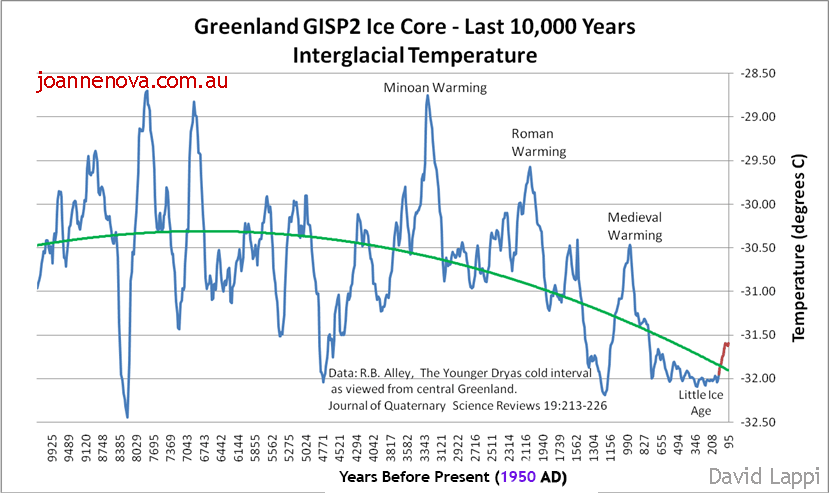 7,000 years of cooling in Greenland. UPDATE: This graph shows the ice-core data up until 1855. The last 150 years (1705 to 1855) are highlighted in red to show the warming as the Earth began coming out of the LIA. But in the last 150 years we’ve warmed out of the Little Ice Age and despite humans building the first coal fired plant in 1880 and putting out 99% of all the carbon dioxide we’ve ever put out, the temperature there has barely moved at all. About 6,500 million people have been born on Earth since 1880 and it’s made hardly any difference.
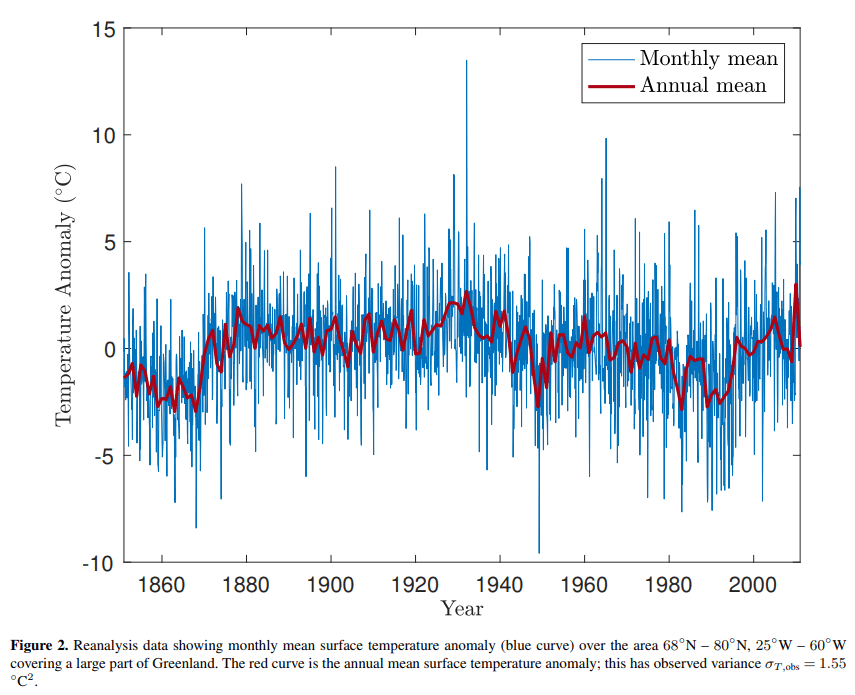 Greenland surface temperatures ( Mikkelsen et al., 2018) So despite the climate of Greenland being in the news every year, somehow the award winning journalists and the Nobel prize winning scientists forget to mention that the temperatures on Greenland have been largely stable recently despite humans emitting 1.7 trillion tons of CO2.They also fail to explain that Mother Nature is a thousand times more brutal than anything our cars, trains and planes have done.
But who cares about cause and effect? There’s always a way to make it look bad: Big Meaningless Numbers!
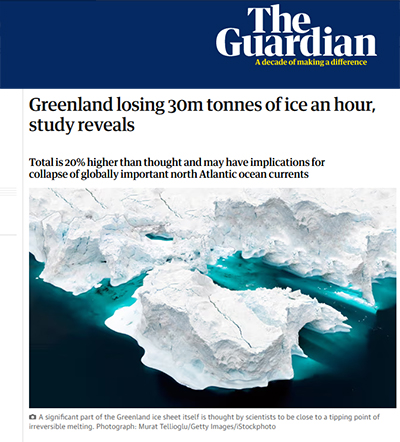
PS: Today in Greenland, a fisherman actually netted a fish with three eyes. Someone should tell the Australian Labor Party. They need it to explain their national energy policy.
REFERENCES
Kolja Kypke, Peter Ditlevsen (2024) On the representation of multiplicative noise in modeling Dansgaard–Oeschger events, Physica D: Nonlinear Phenomena, Volume 466, October 2024, 134215, https://doi.org/10.1016/j.physd.2024.134215
Mikkelsen, T. B., Grinsted, A., and Ditlevsen, P. (2018)Influence of temperature fluctuations on equilibrium ice sheet volume, The Cryosphere, 12, 39-47, https://doi.org/10.5194/tc-12-39-2018, 2018. Full paper plus Supplement
Greenland photo by Johannes Plenio on Unsplash
9.9 out of 10 based on 86 ratings
|
JoNova A science presenter, writer, speaker & former TV host; author of The Skeptic's Handbook (over 200,000 copies distributed & available in 15 languages).

Jo appreciates your support to help her keep doing what she does. This blog is funded by donations. Thanks!


 Follow Jo's Tweets
Follow Jo's Tweets To report "lost" comments or defamatory and offensive remarks, email the moderators at: support.jonova AT proton.me
Statistics
The nerds have the numbers on precious metals investments on the ASX
|

















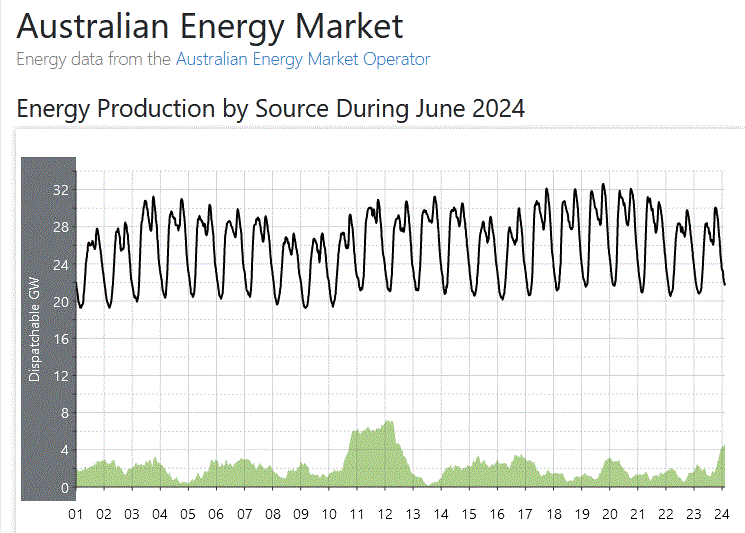


















Recent Comments